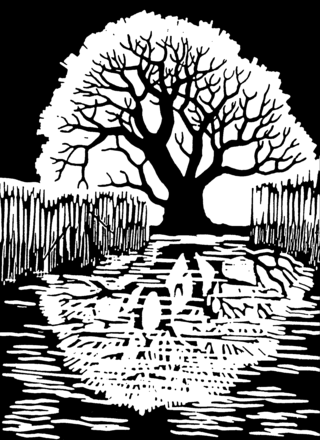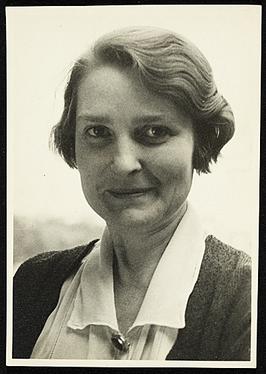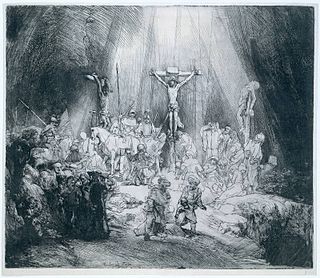Ernest Alexander Pickup (1887-1970) was an American printmaker.
Ernest Alexander Pickup (1887-1970) was an American printmaker.
Ernest Alexander Pickup was born April 10, 1887, in Shelbyville, Tennessee, the son of George Alexander Pickup and Rebecca Cannon. As a young man he moved with his family to Brooklyn, New York in 1894 where he attended school before moving to Baltimore, Maryland. When Ernest completed the 5th grade (age 12) the family moved back to Brooklyn where Ernest was enrolled as an apprentice at the Organ Printing Company along with his father to learn the printing business. In 1904 the Pickups returned to Tennessee where they established a rubber stamp business, G. A. Pickup and Son.
In 1912 he began a career as a commercial artist, and over the next 18 years built a successful business in Nashville. During the Depression, however, Pickup's business, like most in America, began to suffer. With time on his hands, Pickup began experimenting with wood engraving in the early 1930s. He studied the work of other artists –primarily Claire Leighton, Rockwell Kent and Thomas Nason and to a lesser extent Thomas Hart Benton and Grant Wood. Claire Leighton's book on wood engraving and woodcuts became his Bible on making woodcuts, but it was Thomas Nason's simple architectural themes and pastoral renderings that inspired his subject matter. Pickup and Nason shared a common view of nature and the countryside, and the majority of his prints reflected his love of nature as well as his appreciation for the historical places and the rural area in and around Nashville.
Pickup was one of only a handful of artists in Tennessee who worked with wood engraving. He exhibited nationally throughout the 1930s, and became nationally recognized for his work. In January 1937 his prints were exhibited in the National Exhibition of Lithographs, Woodcuts, and Block Prints New York City, and from that exhibition one of his prints was selected by The Society of American Etchers for a tour of European Galleries, beginning in Stockholm, Sweden.
His work was included in the “Sixth International Exhibition of Lithography and Wood Engraving,” at the Art Institute of Chicago, November 5, 1937, to January 10, 1938. From that exhibition his print was chosen as one of the best 100 works for a traveling show throughout America.
With America's entry in World War II there was an increased demand for commercial artwork, and as a result Pickup's printmaking suffered. By the late 1940s he had returned full-time to his commercial artwork. He remained, however, connected to the arts community well into the 1950s. He still exhibited his work occasionally and gave occasional lectures on woodblock printing to local organizations.
In 1962 at the age of seventy-five he closed his business with the intention of retiring. Before he was able to move out of his studio, he was enticed to work another five years for a printing company for which he had done art work for many years. He died February 24, 1970, in Nashville.
Recently his work was included in an exhibition at the Georgia Museum of the University of Georgia, Athens, Georgia, summer 2007 and is scheduled for the summer of 2008 to be held at Auburn University Art Museum in Alabama.
Little has been written on print making in Tennessee, and in the Fall of 2009 a catalogue raisonné of Pickup's oeuvre was published providing a prime source of information on this long neglected period of art history. Besides a biographical overview and memoirs by the artist's daughter, this work also includes over fifty reproductions of rare prints, many of which have not been seen in over a half a century.
He was better known to family by the nickname of "Bockie" - the name that his first grandchild, Susan, gave to him when he reached into his pocket for a "surprise." She would run up to him and say "bockie" and reach for his pocket. That name "Bockie" stood for dear grandfather.

Printmaking is the process of creating artworks by printing, normally on paper, but also on fabric, wood, metal, and other surfaces. "Traditional printmaking" normally covers only the process of creating prints using a hand processed technique, rather than a photographic reproduction of a visual artwork which would be printed using an electronic machine ; however, there is some cross-over between traditional and digital printmaking, including risograph. Except in the case of monotyping, all printmaking processes have the capacity to produce identical multiples of the same artwork, which is called a print. Each print produced is considered an "original" work of art, and is correctly referred to as an "impression", not a "copy". However, impressions can vary considerably, whether intentionally or not. Master printmakers are technicians who are capable of printing identical "impressions" by hand. Historically, many printed images were created as a preparatory study, such as a drawing. A print that copies another work of art, especially a painting, is known as a "reproductive print".

Woodcut is a relief printing technique in printmaking. An artist carves an image into the surface of a block of wood—typically with gouges—leaving the printing parts level with the surface while removing the non-printing parts. Areas that the artist cuts away carry no ink, while characters or images at surface level carry the ink to produce the print. The block is cut along the wood grain. The surface is covered with ink by rolling over the surface with an ink-covered roller (brayer), leaving ink upon the flat surface but not in the non-printing areas.

Linocut, also known as lino print, lino printing or linoleum art, is a printmaking technique, a variant of woodcut in which a sheet of linoleum is used for a relief surface. A design is cut into the linoleum surface with a sharp knife, V-shaped chisel or gouge, with the raised (uncarved) areas representing a reversal of the parts to show printed. The linoleum sheet is inked with a roller, and then impressed onto paper or fabric. The actual printing can be done by hand or with a printing press.
Gwendolen Mary "Gwen" Raverat, was an English wood engraver who was a founder member of the Society of Wood Engravers. Her memoir Period Piece was published in 1952.

Wood engraving is a printmaking technique, in which an artist works an image or matrix of images into a block of wood. Functionally a variety of woodcut, it uses relief printing, where the artist applies ink to the face of the block and prints using relatively low pressure. By contrast, ordinary engraving, like etching, uses a metal plate for the matrix, and is printed by the intaglio method, where the ink fills the valleys, the removed areas. As a result, wood engravings deteriorate less quickly than copper-plate engravings, and have a distinctive white-on-black character.

The Society of Wood Engravers (SWE) is a UK-based artists’ exhibiting society, formed in 1920, one of its founder-members being Eric Gill. It was originally restricted to artist-engravers printing with oil-based inks in a press, distinct from the separate discipline of woodcuts. Today, its support extends to other forms of relief printmaking, and awards honorary membership to collectors and enthusiasts.

Intaglio is the family of printing and printmaking techniques in which the image is incised into a surface and the incised line or sunken area holds the ink. It is the direct opposite of a relief print where the parts of the matrix that make the image stand above the main surface.

Shikō Munakata was a woodblock printmaker active in Shōwa period Japan. He is associated with the sōsaku-hanga movement and the mingei movement. Munakata was awarded the "Prize of Excellence" at the Second International Print Exhibition in Lugano, Switzerland in 1952, and first prize at the São Paulo Bienal Exhibition in Brazil in 1955, followed by Grand Prix at the Venice Biennale in 1956, and the Order of Culture, the highest honor in the arts by the Japanese government in 1970.

Grace Thurston Arnold Albee was an American printmaker and wood engraver. During her sixty-year career life, she created more than two hundred and fifty prints from linocuts, woodcuts, and wood engravings. She received over fifty awards and has her works in thirty-three museum collections. She was the first female graphic artist to receive full membership to the National Academy of Design.
Clare Marie Veronica Leighton, sometimes Clara Ellaline Hope Leighton or Clare Veronica Hope Leighton, was an English/American artist, writer and illustrator, best known for her wood engravings.
Isidoro Ocampo was a Mexican artist during the Mexican Muralism era, best known for his graphic work. Much of his career was dedicated to teaching, which kept his artistic output low, but he was also a founding member of the Taller de Gráfica Popular and the Sociedad Mexicana de Grabadores as well as member of the Liga de Escritores y Artistas Revolucionarios and the Salón de la Plástica Mexicana.

An old master print is a work of art produced by a printing process within the Western tradition. The term remains current in the art trade, and there is no easy alternative in English to distinguish the works of "fine art" produced in printmaking from the vast range of decorative, utilitarian and popular prints that grew rapidly alongside the artistic print from the 15th century onwards. Fifteenth-century prints are sufficiently rare that they are classed as old master prints even if they are of crude or merely workmanlike artistic quality. A date of about 1830 is usually taken as marking the end of the period whose prints are covered by this term.

Gustave Baumann was an American printmaker and painter, and one of the leading figures of the color woodcut revival in America. His works have been shown at the New York Metropolitan Museum of Art, The Cleveland Museum of Art, the National Gallery of Art in Washington DC, and the New Mexico Museum of Art. He is also recognized for his role in the 1930s as area coordinator of the Public Works of Art Project of the Works Progress Administration.
Paul Hambleton Landacre was an active participant in the cultural flowering of interwar Los Angeles, described by Jake Zeitlin as a "small Renaissance, Southern California style". His artistic innovations and technical virtuosity gained wood engraving a foothold as a high art form in twentieth-century America. Landacre's linocuts and wood engravings of landscapes, still lifes, nudes, and abstractions are acclaimed for the beauty of their designs and a mastery of materials. He used the finest inks and imported handmade Japanese papers and, with a few exceptions, printed his wood engravings in his studio on a nineteenth-century Washington Hand Press, which is now in the collection of the International Printing Museum in Carson, California.
Jack Glover is an American artist living and working in Richmond, Virginia.
James Thomas Armour Osborne RE (1907-1979) was a British painter, original printmaker, etcher and engraver known for his ornithological and wildlife prints. He was a student at the Royal College of Art, a Rome Scholar, a Fellow of the Royal Society of Painter-Etchers and a founder of the Society of Wildlife Artists.

Byron Gordon McKeeby (1936-1984) was an American artist, educator and master printmaker known primarily for lithography. McKeeby's interest dovetailed with a burgeoning contemporary community in advancing lithography as an art form. He was active in all form of print exhibition. He built a full scope printmaking department of rank at the University of Tennessee that exists today.

Sylvia Solochek Walters is an American artist and educator. She has produced drawings, paintings and collage works in her career, but is best known for complex woodcut prints created through the "reduction and stencil" process. Her work combines elements of realist, decorative and formalist art, flat and illusionistic space, and varied patterning and textures. She has largely focused on portraits, still lifes and domestic interiors, and collage-like combinations of personal symbolism—concerns that writers often align with early feminist art.

Sam Glankoff was an American Abstract Expressionist and woodcut artist.

Herschel C. Logan was an American artist and founding member of the Prairie Print Makers. He is known primarily today for his woodcuts of serene, nostalgic scenes of Midwest small towns and farms -- mostly Kansas subjects -- rendered in precise, clean lines. He earned both international acclaim as well as the nickname "The Prairie Woodcutter".